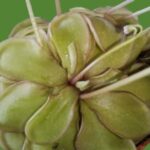As an Amazon Associate, this site earns commissions from qualifying purchases. For more details, click here.
is your new sundew plant suddenly turning a deep red? Maybe not just the leaves but the tentacles or even the entire plant. Should this be something you should worry about or is this normal? This topic can be confusing and even alarming for a new grower, so this guide will explain it in simple terms.
Sundew tentacles and leaves turn red when exposed to sufficient light, and is generally a good sign. However, too much light will burn the leaves, causing the red to turn brown and appear burned out.
Why Sundews Turn Red
The color of your sundew says a lot about its health. Because there are so many drosera species, the meaning of the color red can vary.
In general, sundews that receive an adequate amount of light turns red. The tentacles and leaves (either fully or partially) turn anywhere from light pink to a deep red. However, reddish leaves could also be a sign of sunburn. Too much sunlight and heat turns green sundew leaves into red. Eventually these leaves turn brown and die. Aside from the color change, sunburned leaves have a crispy, textured feel to them.
Not enough light can in certain circumstances, also turn sundews red. Suppose you just bought a sundew plant and grew it in low light. Sundews turn red due to light so the lack of it keeps the plant all green.
If you suddenly expose the sundew to sunlight, it will turn red in a few days or weeks. But the sudden change in temperature, humidity and environment is going to cause sunburn. The leaves red color is only temporary. After a few days or weeks the leaves and tentacles become brownish, wither and die,.
The best way to avoid is to expose the plant to 6-12 hours of light. If sunlight is limited or you want to grow the sundew indoors, use artificial ones like the Roleadro Grow lights.
Sundews do not like sudden changes in environment. In this case, a drosera used to low light that gets exposed to hours of sun will suffer burns. And a healthy, reddish sundew that gets deprived of light will weaken or die.
Lack of nutrition might also cause sundews to lose their reddish color. These plants get their nutrients from insects ad without them, they get weak. Weak sundews are not sticky and lose their color as well.
The bottom line is that sundews turn red when provided with enough light. But too much of it can cause burns and even kill off the leaves.
So is a Red Sundew Good or Bad?
The answer depends on why the sundew is turning red. And you also have to consider other factors to determine what the red color means.
First, some sundews are a natural red. The drosera brevifolia, drosera rotundifolia and the Cape Sundew are all either dark pink or deep red.
If your sundew is a natural red color, there is no reason to worry. But if the shade gets too deep during hot sunny days, it could be an indication of sunburn.
A healthy sundew produces reddish growth. If the color is pale or completely green, something is wrong with the plant, most probably lack of sunlight.
Sundews that lose their dew also turn reddish pink. Since healthy sundews are supposed to have red tentacles and leaves this might cause confusion. To make it simple: if your sundew has dew and is reddish, the plant is fine. If there is no dew and the leaves are reddish pink, the plant is sick.
Lack of sunlight keeps sundews all green. With sufficient light the tentacles turn pink or red. Without enough light the plant cannot produce dew. Or it might generate some but it is going to be more watery than sticky.
To find out if red is good for your sundew or not, keep the following in mind:
- Know if your sundew variant is naturally red. This will give you an idea of what color to expect.
- Observe the dew or mucilage. If your sundew has mucilage and is pinkish red, the plant is fine. If the leaves and tentacles are red but without dew, the plant needs more light.
- Examine the leaves. Burnout leaves feel crisp and have a burned out appearance. Healthy and burned sundew leaves are both red, but burnt ones have a worn out look to them.
Prevent Sundews From Turning Red Due to Sunburn
The good news is that a few burned out leaves will not kill your sundew. The following are preventive measures you can take.
Shade sundews if it gets too hot. Most sundews can handle temperatures up to 85 F, but some species can cope with heat up to 90-100 F. Check the recommended temperature range for your plant. If it gets too hot, place the plant under shade.
Keep your sundew in a moist, humid environment. Allow your sundew to sit in water during summer. This will keep it cool and avoid sunburns. If your plant is indoors there should be come protection from outdoor heat. Move the plant indoors or under shade if it is too hot.
If your sundew is all green due to low light, you might be tempted to expose it to the sun right away. While this will turn the leaves red it could burn the entire plant.
A better approach is to slowly acclimatize the sundew to light and heat. Slowly increase the light and heat exposure of your plant. Do this over a period of several weeks.
Eventually the sundew will get used to this .You will see the plant tentacles and leaves turn red but without losing their dew or burning.
This takes some getting used to and is not as easy as it sounds. Some drosera species are very sensitive to changes in light, humidity and heat.
The best approach is to provide the right amount of sunlight for the sundew. This will allow the plant to attain that red color without burning out.
You can use grow lights to turn drosera red. Fluorescent lights at about 5000k will produce color changes quickly. But be careful as it could burn the leaves.
How to Keep Sundews Healthy
If you know the signs of a healthy sundew, you do not have to worry about its color. As long as the plant eats and produces healthy, colorful leaves and dew, it is fine. Here are some more tips.
- Learn as much as you can about the drosera species. No two drosera variants are exactly alike. Research as much as you can about the species you want to buy so you know what to expect.
- Growing sundews need to be fed 4 times a month. If your plant is outdoors and is fully grown, let it hunt for insects. If indoors, you can opt for beta fish pellets and small insects. You can also feed them Downtown Pet Supply Dried Mealworms as it is nutritious and makes sundews healthier.
- Grow the plant in the right environment. The right setting usually means sitting the plant in water (the tray method) with 6 to 12 hours of light. High humidity is ideal and temperatures no higher than 85 F.
- Plant the sundew in poor soil. Fertilize or typical potting soil is one of the many reasons sundews can suddenly die.
If you have several sundews of the same species, observe their appearance. Use this to compare their health, feeding habits etc. This makes it easier to determine which plants are healthy and which are not.
Keep in mind that sundews need plenty of water. So add more to the tray during summer. This is important as dry soil can be harmful to the plant.
The best way to care for sundews is to give it enough light and water. Use the right soil and feed it small amounts of healthy food and you are good to go. In truth, caring for these carnivorous plants is fairly straightforward.
Conclusion
So as you can see, a red sundew can mean different things. In some cases it is a sign of good health and in others it is not. That is why it is important that you learn as much as you can about the variant or species you bought.

My fascination with carnivorous plants began many, many years ago with Venus Fly Traps. Now I am more than happy to impart what I know with other enthusiasts and those who are curious about meat eating plants.



